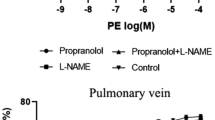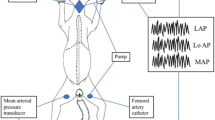NO-mediated vasodilatation can be realized via two pathways: dependent and independent on soluble guanylate cyclase; the latter is implemented through NO interaction with ionic channels. We evaluated the contribution of these pathways into NO-induced relaxation of isolated pulmonary arteries in rats. In pulmonary arteries, in contrast to systemic vessels, soluble guanylate cyclase-independent mechanisms is more important, because it mediates relaxation in response to low concentrations of NO donor. The role of soluble guanylate cyclase-dependent mechanisms in the mechanisms of vasodilatation increases with increasing NO donor concentrations.
Similar content being viewed by others
References
Wolin MS, Davidson CA, Kaminski PM, Fayngersh RP, Mohazzab HKM. Oxidant--nitric oxide signalling mechanisms in vascular tissue. Biochemistry. 1998;63(7):810-816.
Davydova MP, Postnikov AB, D’iakonov KB, Liubitskiǐ OB, Medvedeva HA. Involvement of tetrahydrobiopterin in local change of endothelium-dependent vasorelaxation in pulmonary hypertension. Ros. Fiziol. Zh. 2003;89(12):1516-1522. Russian.
Nedospasov AA. Competition involving biogenic NO. Biochemistry (Moscow). 1998;63(7):744-765.
Evans AM, Osipenko ON, Haworth SG, Gurney AM. Resting potentials and potassium currents during development of pulmonary artery smooth muscle cells. Am. J. Physiol. 1998;275(3, Pt 2):H887-H899.
Hampl V, Herget J. Role of nitric oxide in the pathogenesis of chronic pulmonary hypertension. Physiol. Rev. 2000; 80(4):1337-1372.
Mistry DK, Garland CJ. Nitric oxide (NO)-induced activation of large conductance Ca2+-dependent K+ channels (BK (Ca)) in smooth muscle cells isolated from the rat mesenteric artery. Br. J. Pharmacol. 1998;124(6):1131-1140.
Yuan XJ, Tod ML, Rubin LJ, Blaustein MP. NO hyperpolarizes pulmonary artery smooth muscle cells and decreases the intracellular Ca2+ concentration by activating voltage-gated K+ channels. Proc. Natl Acad. Sci. 1996;93(19):10 489-10 494.
Zhao YJ, Wang J, Rubin LJ, Yuan XJ. Inhibition of K(V) and K(Ca) channels antagonizes NO-induced relaxation in pulmonary artery. Am. J. Physiol. 1997;272(2, Pt 2):H904-H912.
Author information
Authors and Affiliations
Corresponding author
Additional information
Translated from Byulleten’ Eksperimental’noi Biologii i Meditsiny, Vol. 167, No. 2, pp. 200-203, February, 2019
Rights and permissions
About this article
Cite this article
Davydova, M.P. The Structure of NO-Mediated Dilatation of Pulmonary Arteries Depends on NO Availability. Bull Exp Biol Med 167, 247–249 (2019). https://doi.org/10.1007/s10517-019-04501-4
Received:
Published:
Issue Date:
DOI: https://doi.org/10.1007/s10517-019-04501-4




